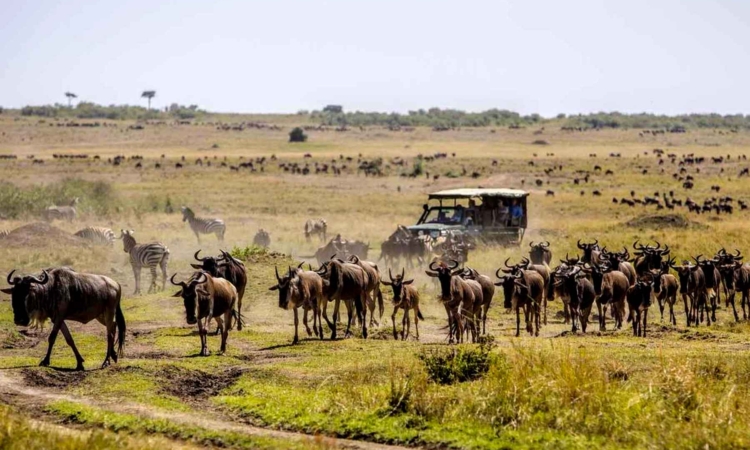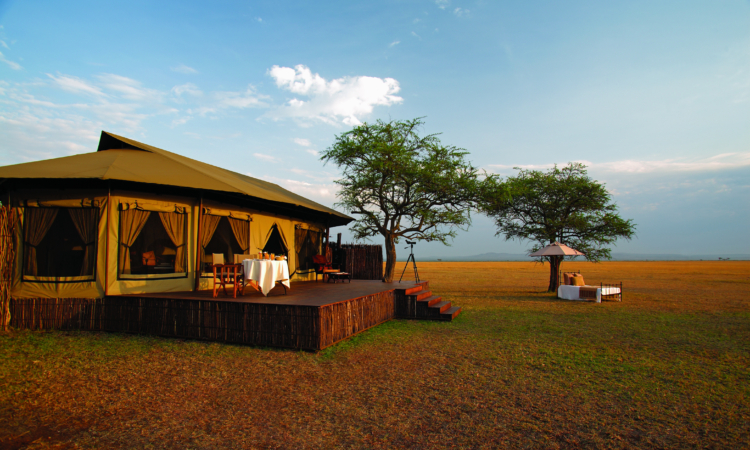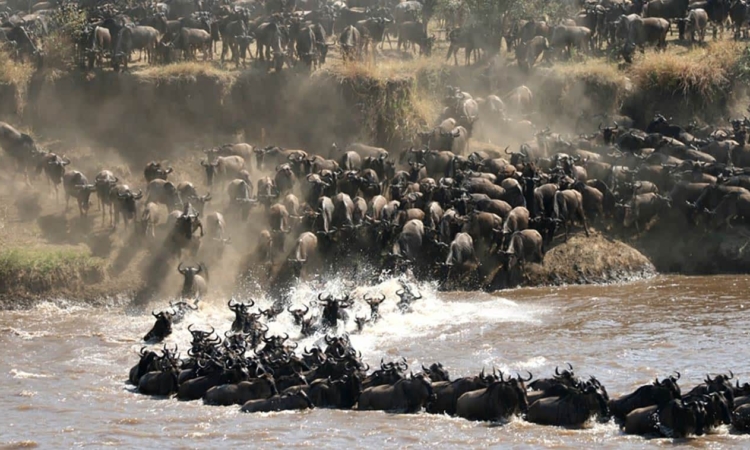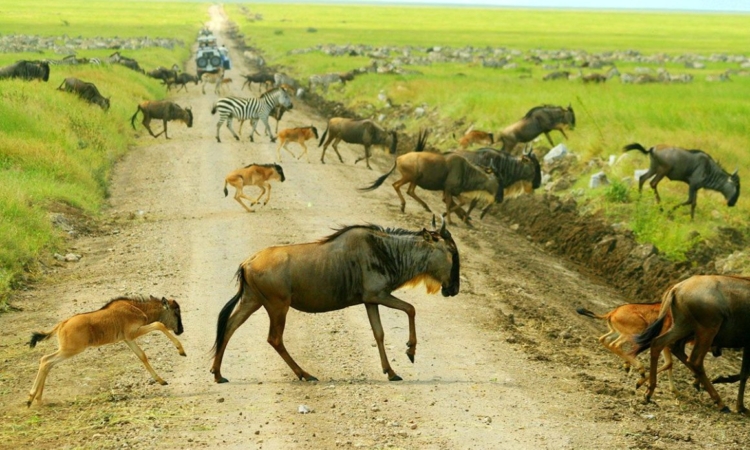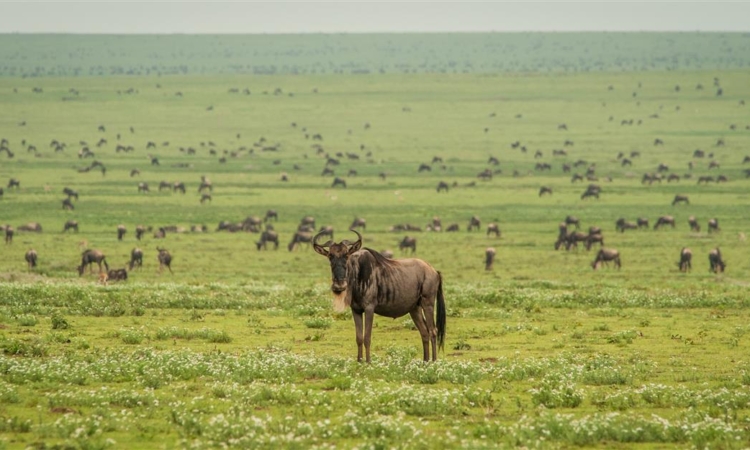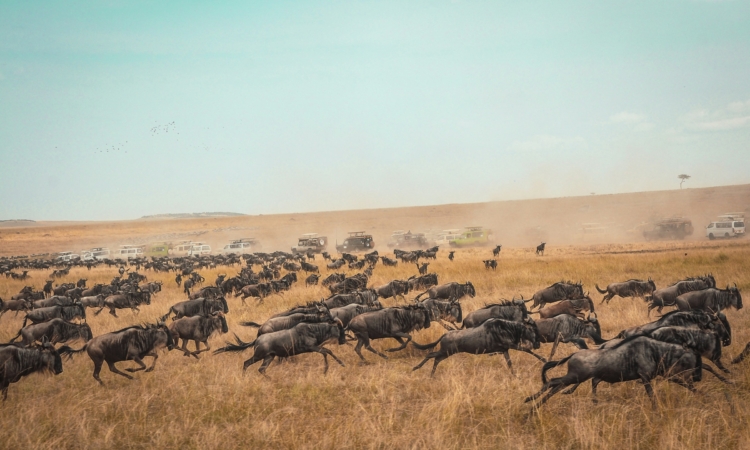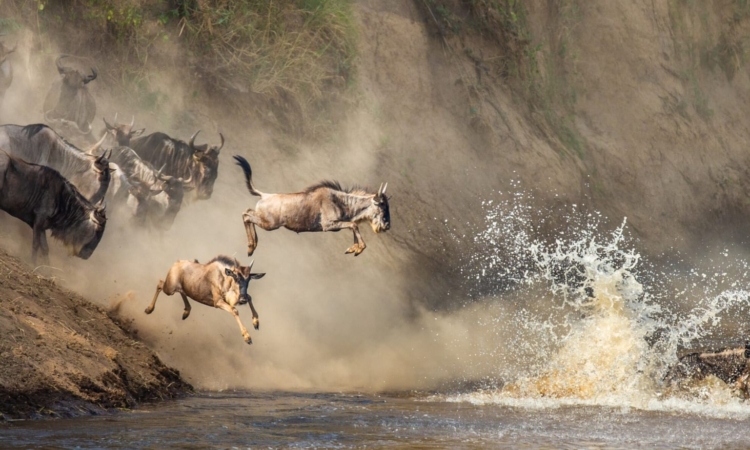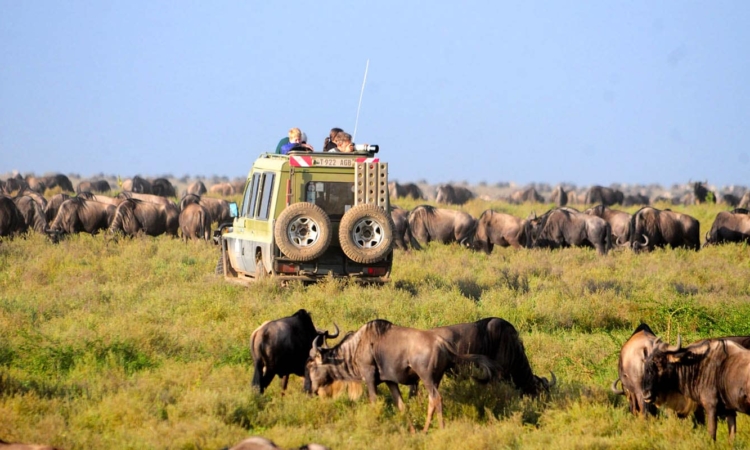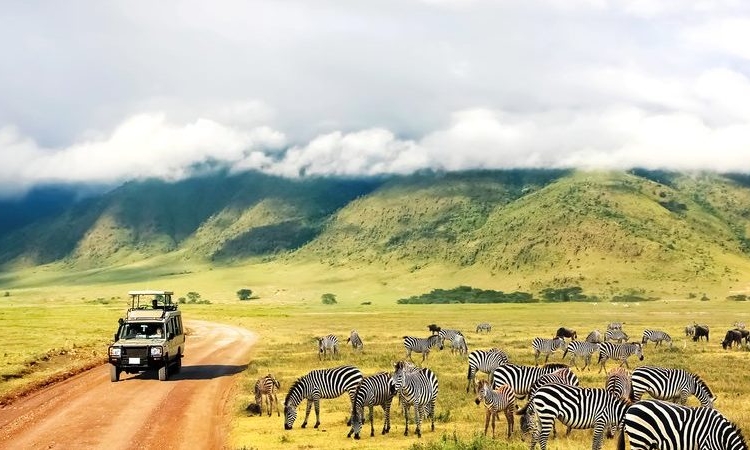The wildebeest migration is one of the most amazing events on Earth. It is best experienced on a Kenya safari or a Tanzania safari. Often referred to as the “World Cup of Wildlife,” the migration is indeed a remarkable spectacle.
It is rated among the seven natural wonders of the world and is an unforgettable wildlife experience.
Wildebeest Migration Video: Mara River Crossings Video by National Geographic
What is the Great Wildebeest Migration?
The great wildebeest migration is one of the most powerful natural phenomena on Earth. This massive annual movement involves millions of wildebeests, along with large numbers of other grazers, such as Grant’s gazelles, Thompson’s gazelles, zebras, impalas, and elands, traversing the Greater Masai Mara-Serengeti Ecosystem.
From July to September, the Masai Mara receives thousands of wildebeests and zebras migrating from the Serengeti in Tanzania to the Masai Mara National Reserve in Kenya. During this time, tourists can witness the intense battle for survival, making the migration an experience worth every moment.
The Mara River crossing marks the climax of the migration, bringing excitement, inspiration, and emotional moments as the wildebeests brave the river, evading crocodiles lurking in the waters.
Why Does the Migration Occur?
The migration’s pattern is largely determined by rainfall. The cycle begins in the southern Serengeti in Tanzania, around the Ndutu area, where the wildebeests take a zig-zag path, making their movements somewhat unpredictable. In the south, short rains start from November to mid-December, leading the migration back to this area.
From mid-December to March, the short-grass plains in the southern Serengeti, particularly in Ndutu and the Ngorongoro Conservation Area, provide ample grazing. During this time, between late January and March, about 80% of wildebeest calves are born, thanks to abundant water. This period is considered one of the best times to visit Serengeti National Park for the migration experience.
From April to early June, as the long rains begin, the wildebeests move toward the Seronera area. The wet season brings lush vegetation, attracting a wide range of wildlife, making it an ideal time for photography. However, the short grass cannot sustain the large herds, prompting them to head north and west.
From April to June, the Serengeti becomes a hub for these creatures as they journey towards the Seronera region and eventually reach the Grumeti River. Predators like cheetahs, leopards, lions, and hyenas follow the migration closely.
In the Seronera region, the vast plains and scenic kopjes provide perfect vantage points for observing both resident wildlife and migrating herds from April through May.
By June, as the western corridor becomes depleted, the wildebeests continue northward toward Grumeti. This area is drier, facilitating easy navigation, and camps are strategically located to allow observation of permanent residents, such as zebras.
Starting in July, they move to the northern Serengeti, situated between Seronera and the Kenya border. From late July to September, visitors witness the dramatic river crossings, where large numbers of zebras and wildebeests cross the Grumeti and Mara rivers to reach the lush pastures of the Masai Mara Reserve in southern Kenya.
Between November and December, as the dry season sets in and fresh grass diminishes, the wildebeests head south again. They recross the rivers and continue toward Tanzania as short rains begin in November.
The Masai Mara Migration
The wildebeest migration is an extraordinary event, occurring in only two destinations in Africa: the Masai Mara National Reserve in Kenya and the Serengeti National Park in Tanzania. The Masai Mara migration can only be experienced on a Kenya safari in the Masai Mara National Reserve.
The Masai Mara National Reserve is a vast savanna wilderness in southwestern Kenya, spanning over 1,510 square kilometers along the Great Rift Valley. This protected area borders Tanzania’s Serengeti National Park, allowing free movement for animals.
The Masai Mara features diverse terrain: the Ngama Hills in the east, with short bushes; the Siria Escarpment, which forms the western boundary and an impressive plateau; and the Mara Triangle, which borders the Mara River. Here, visitors can find beautiful grasslands and acacia trees, home to a wide range of wildlife, including migrating wildebeests.
The Serengeti National Park, located in northern Tanzania, is another prime location for witnessing the migration. This vast conservation area covers 15,000 square kilometers and has three main sections. Its proximity to the Masai Mara Reserve enables seamless movement of wildlife between the two areas. The Serengeti is home to many other species, including leopards, cheetahs, lions, baboons, and a variety of bird species.
How the Wildebeest Migration Occurs Between Masai Mara, Kenya, and Serengeti, Tanzania
The great wildebeest migration is an incredibly magical experience and a natural wonder worth witnessing on any safari.
The movement of the wildebeests is unpredictable, often influenced by weather conditions and seasonal changes.
Here’s an overview of how this remarkable migration typically unfolds:
Birthing/Calving Season
An estimated 300,000 to 400,000 wildebeest calves are born between January and February. Calving usually occurs in areas with short grass, extending from the southernmost part to the lower northern side of the Ngorongoro Crater in Tanzania. From February to March, wildebeests remain in the Southern Serengeti, where ample pasture is available. During this period, over 8,000 calves can be born in a single day.
The annual calving season attracts numerous predators, making it a feast for animals like hyenas and lions. Witnessing wildebeests giving birth is an astonishing wildlife encounter not to be missed on a safari to experience the migration in Masai Mara or Serengeti, Tanzania.
Unlike other ungulates, newborn wildebeests gain coordination quickly. Within 2-3 minutes after birth, a calf can stand, and by 5 minutes, it can even start running.
Movement to the North
Starting in April, the wildebeest migration begins, and herds start moving north. By May, a line of wildebeests, stretching for about 40 kilometers, can often be seen heading northward. As the dry season sets in from late May, the journey toward the Mara River intensifies in search of water.
In July, the herds are visible in the western Serengeti National Park and the Grumeti Reserves, where they pause to organize for the river crossing. They often wait due to the presence of Nile crocodiles in the river.
The Mara River Crossing
By August, after crossing the Mara River, the surviving wildebeests can be seen grazing as they proceed into the Masai Mara National Reserve. For a breathtaking view of this journey, Kenya is an ideal destination. Many tourists gather in Masai Mara in October to witness the great migration. In addition to observing the migration, visitors also have an opportunity to engage with the Maasai community.
Return Journey
A high concentration of wildlife can be spotted during game drives at this time, as the thin vegetation provides a clear view. Most wildebeests begin their return to the Serengeti around late December as the rainy/wet season begins.
Should You Visit Kenya or Tanzania?
Choosing between Kenya and Tanzania for an African safari can be challenging. However, we recommend visiting both destinations for a comprehensive wilderness experience.
These two countries are the only destinations in Africa where you can witness the wildebeest migration.
No matter your safari needs, we are here to customize an affordable package tailored to your travel interests.
About African Wildebeests
African wildebeests, also known as gnus, are members of the antelope family. They have large, box-like heads and curved horns, with a heavy, muscular front end that becomes slenderer toward the back, supported by spindly legs. Wildebeests have a gray coat and black mane. They come in different subspecies, with the Mara-Serengeti ecosystem in Kenya and Tanzania home to the western white-bearded wildebeest and the eastern white-bearded wildebeest, which thrive east of the Rift Valley.
Wildebeests weigh between 118 and 270 kg, with females experiencing a gestation period of 8.5 months. They are typically 5-8 feet long and have tails 14-22 inches in length. These animals are primarily grazers, favoring sweet, stocky grasses. Wildebeests are generally sociable and territorial. Their mating season, known as the rut, is associated with the full moon, when territorial males are ready to mate. During this period, breeding clusters of around 150 wildebeests form within larger herds. In these clusters, 5-6 dominant bulls establish and defend territories, which cows then pass through.
Female wildebeests reach sexual maturity at 16 months, though they usually don’t mate until they are 28 months old. They are highly fertile and have a high conception rate. Like humans, female wildebeests have a gestation period of 8-8.5 months. Unlike other wildlife, wildebeests give birth within a short timeframe, often around the start of the wet season.
Interestingly, wildebeests typically produce one calf within the center of the herd rather than seeking an isolated area, a common behavior across most antelope families. Incredibly, over 80% of the females in a herd may give birth within the same 2-3 week period. The high birthing rate increases the calves’ chances of survival against predators. After birth, the mother licks the calf, and within 6 minutes, the calf can stand. The mother stays close to the calf during its first two days.
Newborn wildebeests are yellowish-brown, and they change color as they grow, typically around two months of age. They nurse for about 4 months, but they start grazing on grass after just 10 days. Young wildebeests remain with their mothers until they are weaned, often staying together until the next year’s calf is born. Young females generally remain with their mothers’ herds, while young males may be sent away. At around 8 months, young wildebeests leave their mothers and form peer groups.
Migration: Each year, the wildebeest migration between the Serengeti and Masai Mara covers a circular route of 500-1,000 miles. Following the birthing season from January to February, the migration begins in the southeastern Serengeti. The wildebeests move through short-grass plains, reaching Lake Victoria in the west, then proceeding through woodlands and curving northward toward the Mara. On their southward return, they exhibit remarkable determination, though many die, are injured, or get lost, especially calves, when crossing rivers.
Best Time to See the Migration
The best months to witness the migration are between December and March or May and November.
The migration is largely influenced by rainfall, which is unpredictable, so wildebeests don’t follow a strict schedule or a set trail.
This unpredictability adds to the unique experience of the migration, as thousands of animals move in various directions but ultimately head toward the same destination across the savanna plains.
Choosing Your Great Migration Safari Packages
Choosing a great migration safari is one of the best decisions for an African safari holiday.
It offers a rare chance to witness a massive terrestrial wildlife movement.
This is one reason Kenya and Tanzania are must-visit destinations, especially around mid-year, when the migration is most active.
You can choose your migration safari based on the events you want to experience.
The birthing season occurs from February to March in the southern Serengeti; the breeding season is from April to May in the western and central Serengeti; the Mara River crossing happens from July to August in northern Serengeti and Masai Mara; and the Grumeti River crossing takes place from May to June in central Serengeti.
Wildebeests migrate from November to January, moving from the Masai Mara and northern Serengeti to southern Serengeti, meaning that migration safaris aren’t limited to July through October.
You can enjoy Kenya’s or Tanzania’s highlights on a 6-day Masai Mara tour or a 6-day Serengeti tour.
Best Masai Mara Migration Season
The best time to witness the migration in the Masai Mara National Reserve is from July to October, when nearly 1.5 million wildebeests can be seen making their way into Masai Mara, Kenya.
Best Serengeti Migration Season
The prime Serengeti migration season runs from July to October/November. This is an ideal time to witness wildebeests as they move toward the northern Serengeti National Park in Tanzania.
Fascinating Wildebeest Migration Facts
- During migration, approximately 250,000 wildebeests and 30,000 zebras are killed annually due to predator attacks.
- The wildebeest migration in northern Tanzania and Masai Mara, Kenya, is the largest land migration on Earth. Wildebeests cover 800 km or more each cycle.
- Over 1.5 million wildebeests are joined by various other wildlife during the migration.
- The migration has no designated leader. Although the movement may appear chaotic, it is a coordinated behavior often described as “swarm intelligence,” where the herd navigates obstacles as one.
- Each year, about half a million wildebeest calves are born between January and February.
- Calves can walk independently within just 2 minutes of birth.
- Wildebeests consume over 4,500 tons of grass daily.
- Wildebeests belong to the antelope family.
Where to Stay
There are numerous accommodation options for tourists in both the Masai Mara and Serengeti. In Masai Mara National Reserve, available options include Mara Ngenche Luxury Tented Camp, Cottar’s 1920s Camp, Mara Bush Camp, Mara West Chalets, Elewana Sand River, Maasai Serena Safari Lodge, Matira Camp, Tembo Tented Camp, and others.
In the Serengeti, popular choices include Serengeti Lodge, Four Seasons Safari Lodge, Ikoma Tented Camp, Serengeti Migration Camp, Seronera Wildlife Lodge, Mawe Luxury Tented Camp, and many more.


